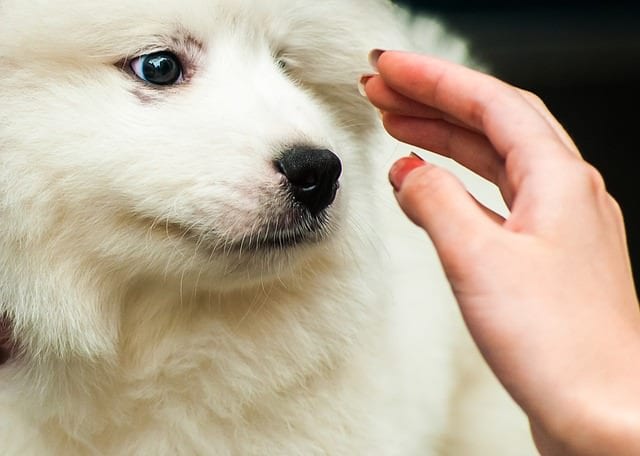
We all want our dogs to feel confident and safe, especially when meeting new people. Unfortunately, this isn’t always the case. Whether from poor genetics or traumatic experience, some dogs are very shy and need to build trust with humans. While this isn’t necessarily a bad thing, it can be problematic if owners try to force their dogs into stressful situations when they’re not ready.
Shy dogs are typically the ones that bite out of fear – they’re not mean, they’re just scared. Rehabilitating a nervous dog takes a lot of time and effort, but there are things you can do to help build their confidence. They might never be social butterflies, but you can still help them become more comfortable around strangers.
How to Build Trust With a Shy Dog
All dogs can be shy, but it’s most common in dogs with rough pasts, such as puppy mill survivors or former strays. If you recently adopted a shy dog, you might feel disappointed if they’re not warming up to you. But trust takes time to build, and the results are so rewarding.
So, here are nine ways you can form a bond with your shy dog.
#1 – Be Patient

As already stated, working with a shy dog takes time and effort. Patience is a virtue here because rushing a frightened dog into something they aren’t ready for is a recipe for disaster. Not only will you set back any progress you’ve made, but you can worsen the situation.
Think about helping someone through a phobia – contrary to popular belief, you don’t just toss people right into their worst nightmare to help them overcome it. You take baby steps and celebrate small victories. This is what you do with shy dogs. Help the dog be comfortable around you, then add strangers, other animals, and new places.
Try not to get discouraged because this will only further stress your dog. You are the person they know best, so when you become upset, they will feel even less confident. Every dog’s timeline is different, so let your dog come to you on their terms and don’t rush anything.
#2 – Avoid Eye Contact

For most humans, eye contact is considered polite, but dogs don’t see it the same way. Many animals see direct eye contact as a threat, so a dog who isn’t familiar with human behaviors might get nervous if your eyes are on them.
When you approach a nervous dog, it’s best to avert your eyes. Most shy dogs also feel more comfortable if you approach with your back or side facing them rather than walking directly toward them.
#3 – Know Your Dog’s Limits

Every dog is different, so paying attention to your dog’s behaviors and reactions can help you gain their trust. For example, some dogs love being talked to, especially when you’re using “baby talk.” However, other dogs might not associate human voices with positive memories, so they might feel more comfortable sitting in silence.
People also tend to assume that all dogs love to be petted, but shy dogs are usually indifferent or afraid of physical contact at first. If your dog shows signs of fear, such as whining, shaking, averting their eyes, or growling, you should stop petting them and give them some space.
When getting your dog used to pets, scratching them under the ears is a good place to start. Go in for a pet with your hand low rather than raising it above their head to avoid triggering memories of abuse.
#4 – Stay at Your Dog’s Level

If everyone towered over you, you’d probably be scared too. So, when interacting with your shy dog, get down to their level as much as possible. Crouch or sit down near them when offering them treats, toys, and affection. They may be more receptive to it if they don’t see you as a giant.
Dogs can’t speak the same language as us, so telling them it’s “okay,” or “safe” won’t do anything. However, they can pick up on the tone of your voice. So, whenever you speak to them, keep your voice calm and soft to avoid startling them.
#5 – Provide a Comfortable Environment

During your shy dog’s first days home, keep the space as calm and quiet as possible. Set up an area that’s just for your dog so they can retreat to it if they feel overwhelmed. This space can be a corner of a house where their crate, bed, and toys are. Make sure these items are their own and not shared by another pet.
If your dog goes to hide in their space, leave them alone and give them time to decompress. If your dog wants attention, they will come to you. But if you chase them down too much, they may act aggressively out of fear. It can be difficult not to pet and cuddle an adorable dog, but shy dogs adjust better if you leave them be until they learn to trust you.
Sometimes playing music can help relax dogs. According to a study, dogs prefer soft rock and reggae.
#6 – Walk A Lot

Many dogs are shy because they haven’t been exposed to enough of the world. You shouldn’t take your nervous dog into a packed pet supply store. But you can start by taking walks in areas your pup is comfortable in. Start in your neighborhood, then branch out to nearby neighborhoods, parks you frequent, and eventually, everywhere you can.
The more your dog gets out and sees the world, the more confident they’re going to be. Protect your dog from strangers and other dogs, as flooding them with introductions can be traumatic. Walk quietly with just you and the family and let others know that your scared pooch isn’t quite ready to say hello to strangers.
Remember not to coddle your dog too much on these walks, either. You need to walk confidently and with purpose, showing your dog that there is nothing to worry about. If they are frightened by a trash truck, just keep strolling by. The more you act like being outside in new places is no big deal, the more your confidence will spread down the leash to your dog.
#7 – Slowly Meet New People

Many shy dogs are scared of certain people, such as men with deep voices or beards. Sometimes, this means they were abused by someone of that description, but other times, they’re just not familiar with a certain variety of people. Most volunteers at shelters and rescues are women, so that’s why it’s more common for dogs to be hesitant around men.
So, once your shy dog becomes more comfortable going out in public, you can try introducing them to a variety of people. Start by walking them near strangers but not getting so close that it worries your dog. As they get more confident, you can let new people try to give them a treat to gain their trust.
If your dog shows signs of nervousness when meeting new people, such as trembling or growling, don’t force the interaction. Remember, just because someone wants to pet your dog doesn’t mean you should let them. Pay attention to your dog’s body language to help you decide if they seem okay with the interaction before proceeding.
#8 – Take A Class

Training your dog is an excellent way to strengthen your bond and build confidence. Taking a fun class like obedience, agility, or nose work will expose your dog to new sights and sounds and help them work confidently for rewards. Using positive reinforcement is key because too much punishment or negative feedback is going to stress a nervous dog.
You want to reward your pup with treats and toys, so they gain confidence in their actions. Think about when you’re learning something new – don’t you feel a sense of pride and accomplishment when you’re able to perform a new task or build a new skill? Your dog is the same way.
Working together will help solidify the bond you have, your dog will know they can comfortably trust you, and you’ll have a lot of fun working together. Soon, if you want, you’ll be doing advanced training in a place your previously shy dog has never been!
#9 – Try Games

There are a few exercises you can do to build trust in your shy dog. The first option is for dogs who are scared to approach you. Find a space they’re comfortable in and a treat they love. Then, walk toward your dog, set the treat about halfway between the two of you, and keep backing up until your dog feels comfortable enough to grab the treat. As you repeat it, your dog will learn they can walk toward you to get treats.
Another option is tossing a treat behind your dog when they look at you. They’ll have to turn around to eat it and then turn back toward you if they want another treat. This is another way to teach your dog that looking at you or approaching you is associated with something positive.
Once a shy dog is comfortable approaching you, you can help them get used to the human touch. For this exercise, if your dog approaches you, gently pet them for a few seconds. Avoid the belly or top of the head because those spots can be intimidating. Then, put your hands down to see what your dog does. If they walk away, then don’t push any further. If they stay put, pet them again for a few more seconds. Over time, your dog may have positive reactions when you continue petting, such as wagging their tail or moving closer when you stop.
Eventually, you can move on to regular training and tricks with your shy dog once they’ve learned to trust you. Some dogs will take longer to get to that point than others.
Is a Shy Dog Right for You?
If you’re thinking about adopting a shy dog, it’s a big decision. Shy dogs can make great companions, and it’s heartwarming when you finally earn their trust, but it’s also a lot of work.
You need to be patient about when your dog will reach milestones. Sometimes, it takes months or even years for severely shy dogs to act as comfortable as other dogs. You should also have a quiet, comfortable space to help them come out of their shell. A fenced-in yard can help with the adjustment.
Shy dogs aren’t for everyone, but they can form the best bonds with their humans when given the right environment. So, if you’re willing to take things slowly, then you might be the perfect dog parent for a shy pup. If you prefer a more outgoing dog, there are always plenty of those up for adoption as well.
The post 9 Ways To Build Trust In A Shy Dog appeared first on iHeartDogs.com.
via Whisker Therapy